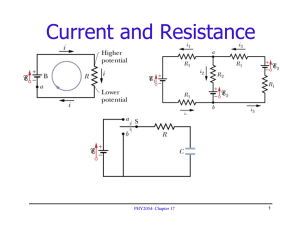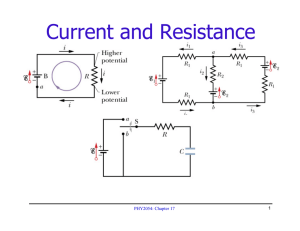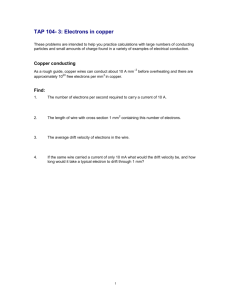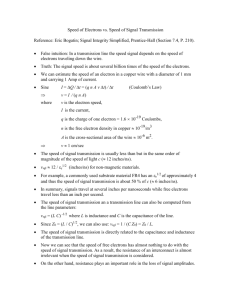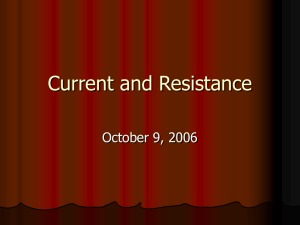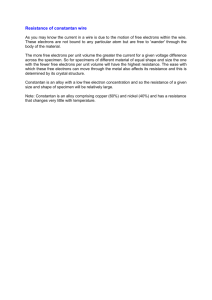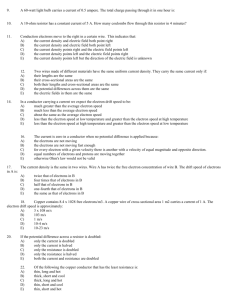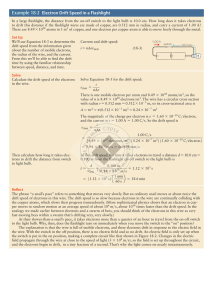Current and Resistance PHY2049: Chapter 26 1
advertisement
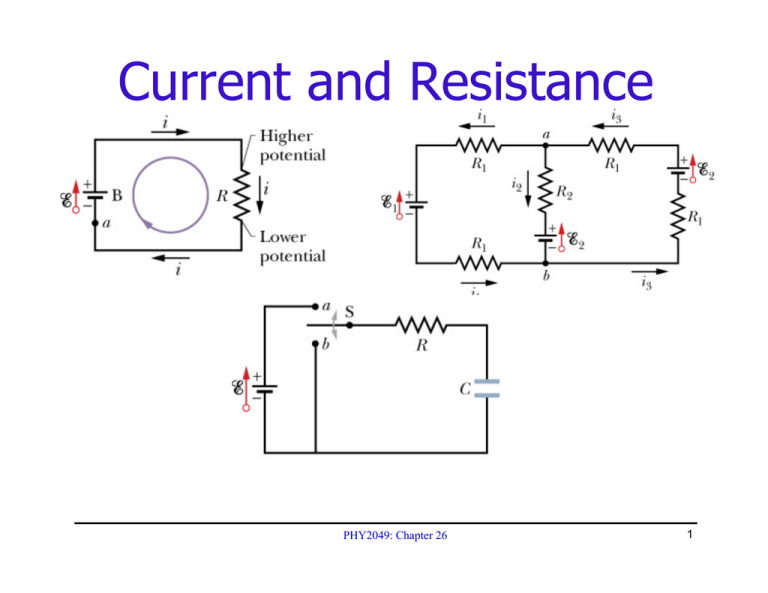
Current and Resistance PHY2049: Chapter 26 1 What You Will Learn in This Chapter ÎNature ÎDrift of electric current speed, current and current density ÎCurrent and voltage measurements ÎConductivity ÎOhm’s and resistivity law ÎTemperature variations of resistance ÎSuperconductors ÎPower in electric circuits ÎElectrical activity in the heart PHY2049: Chapter 26 2 The electric current is defined as ÎAmount of charge per time ÎAmount of charge per area ÎAmount of charge per volume ÎAmount of charge PHY2049: Chapter 26 3 EMF ÎEMF device performs work on charge carriers Converts energy to electrical energy Moves carriers from low potential to high potential Maintains potential difference across terminals ÎVarious types of EMF devices Battery Generator Fuel cell Solar cell Thermopile ÎExample: Electrolytic reaction Magnetic field Oxidation of fuel Electromagnetic energy Nuclear decay battery Two electrodes (different metals) Immersed in electrolyte (dilute acid) One electrode develops + charge, the other – charge PHY2049: Chapter 26 4 Common dry cell battery PHY2049: Chapter 26 5 Electric Current ÎConnecting the terminals of a battery across device leads to an electric circuit Charge begins to flow: electric current Units: 1 Coulomb/s = 1 Ampere (A) ÎSymbol: + - or Δq = I Δt + V - PHY2049: Chapter 26 6 Direction of the current ÎIn conductors, electrons are free and carry the charge But direction of current is defined as flowing from the positive to the negative terminal So current points in opposite direction from electron movement - - - - I +++ --- In the wire, electrons move very slowly (0.05 mm/s). ~ 1 meter per 5 hours!! PHY2049: Chapter 26 7 Example of Electron Flow ÎConsider a current of 1A. Find the number of electrons flowing past a point per second Δq = 1 A ⇒ 1 coulomb / sec Δt ÎSo, in one second, number of electrons passing a point is Ne = 1 coulomb 1.6 ×10−19 = 6.2 × 1018 electrons PHY2049: Chapter 26 8 Current and Electron Drift Speed ÎConsider a material where current (electrons) is flowing Let ne = # free charge carriers / m3 Let q = charge per charge carrier Let A = cross sectional area of material A - - - - Δx ÎTotal charge ΔQ in volume element moving past a point ΔQ = ( ne AΔx ) q ÎIf using ΔV = AΔx charges moving with drift speed vd, then Δx = vd Δt ΔQ = ( ne Avd Δt ) q ÎThus, current can be written in terms of basic quantities i= ΔQ = ne qAvd Δt PHY2049: Chapter 26 9 Example of Drift Speed Î10A flowing through a copper wire of diameter 2mm Density of Cu = 8.92 g/cm3 1 free electron per Cu atom Atomic mass ACu = 63.5 ÎFind e drift speed vd using i = ne eAvd is electron charge Find Still ne = A: e = 1.6 ×10−19 ( A = π r = 3.14 × 10 2 −3 ) 2 = 3.14 × 10−6 m 2 need ne = density of electrons (#/m3) ρCu mCu ×1 = 8.92 ×103 63.5 ×10−3 / 6.02 × 1023 PHY2049: Chapter 26 = 8.5 × 1028 / m3 10 Example of Drift Speed (cont.) ÎSolve for electron drift speed vd i 10 = = 2.4 × 10−4 m/s vd = ne eA 8.5 ×1028 1.6 × 10−19 3.14 × 10−6 ( ÎThus ÎBut )( )( ) vd is 0.24 mm/sec: ~1 hour to move 1 m electrons actually move ~ 106 m/s in material! This is ~ 4 × 109 times larger than drift speed PHY2049: Chapter 26 11 Electrons in the Wire ÎIf the electrons move so slowly through the wire, why does the light go on right away when we flip a switch? Household wires have almost no resistance The electric field inside the wire travels much faster Light switches do not involve currents None of the above Like a hose full of water when you turn on the faucet PHY2049: Chapter 26 12 Electrons in the Wire, Part 2 ÎOkay, so the electric field in a wire travels quickly. But, didn’t we just learn that E = 0 inside a conductor? True, it can’t be the electric field after all!! The electric field travels along the outside of the conductor E = 0 inside the conductor applies only to static charges None of the above EMF source constantly replenishes E field PHY2049: Chapter 26 13 Current Density Uniform current I J≡ J = "current density" (A/m 2 ) A Surface of area A (normal to current) PHY2049: Chapter 26 14 Current Density Example ÎPrevious example: I = 10 A flowing in 2mm diameter wire ( A = π r = 3.14 × 10 2 −3 ) 2 = 3.14 × 10−6 m 2 I 10 7 2 J= = 3.2 10 A/m × A 3.14 ×10−6 PHY2049: Chapter 26 15 Current Density (More General) I = ∫ J ⋅ dA S J Variable J, curved surface Difference between I and J: • I depends on overall geometry • J(x) is a “local” quantity defined at any point in space S PHY2049: Chapter 26 16 Why Use Current Density? ÎI depends on material properties + shape, size of surface ÎJ depends only on properties at a point in space J(x) depends on material properties and E field at point x Useful when shape is complex or applied field is non-uniform ÎConsider equation for current and drift velocity i = ne eAvd ÎGet current density J = i / A J = ne evd Îvd has magnitude/direction at any point in space ⇒ vector J = ne ev d ÎThis is “atomic-level” definition of J PHY2049: Chapter 26 17
